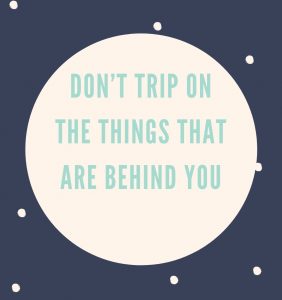 Our dog, Tucker Barktholomew, has this internal clock. Every night at 8pm, he gets up and walks over to my husband and whimpers. It’s his time to go outside in the yard to say farewell to the day and prep for bedtime. He and his sister, Bella Bixby, come in after inspecting the yard for suspicious squirrels, they drink a little water with Bella going first and Tucker second and then they curl up on their beds and drift off. Aren’t we all a little like Tucker? We perform daily rituals such as grinding the coffee beans the night before, setting up our essential oil diffuser by the bed to promote sweet slumber (well, maybe not everyone does this), brushing our teeth or driving to work without thinking of the route we’ll take. These behaviors have been repeated so often that we can perform without purposeful thought and are considered automatic.
Our dog, Tucker Barktholomew, has this internal clock. Every night at 8pm, he gets up and walks over to my husband and whimpers. It’s his time to go outside in the yard to say farewell to the day and prep for bedtime. He and his sister, Bella Bixby, come in after inspecting the yard for suspicious squirrels, they drink a little water with Bella going first and Tucker second and then they curl up on their beds and drift off. Aren’t we all a little like Tucker? We perform daily rituals such as grinding the coffee beans the night before, setting up our essential oil diffuser by the bed to promote sweet slumber (well, maybe not everyone does this), brushing our teeth or driving to work without thinking of the route we’ll take. These behaviors have been repeated so often that we can perform without purposeful thought and are considered automatic.
It wasn’t always like this. These behaviors or habits were created through a gradual shift in our cognitive control. Cognitive control is simply the process where our ambitions (large or small) influence behavior. This can assist us with daily activities that don’t really need special attention such as tying our shoe. It can also help us with long-term goals. Now you see where I’m going!
It’s January…a time when many set New Year’s resolutions. This often requires change. Change isn’t always easy. Our brain prefers automatic repetition and it fights back when we try to change a routine. It’s easier to continue our normal habits, but is that best for your health and wellness? Research shows that it can take 20 to 250 days for a new behavior to become automatic (give or take a few days). To be successful, you may want to consider several factors. I like to call these the Fundamental 5.
1. Own it! Is this something you want or something a loved one or friend wants for you? You need to own it. By doing so, this increases the likelihood that you’ll stick with it!
2. Baby steps! Don’t overwhelm yourself. Making numerous changes at once (exercising, less screen time, sleeping more, eating healthier, visiting family more) can be too much of a good thing. Examine your life and determine what you can handle. Create a plan to make it successful. If you already see obstacles in your path, the likelihood of creating a new healthy habit may not be successful. For instance, if you want to attend a cycle class at 5:30pm and you know that you often work late because you get tied up with meetings, afternoon may not be the best time to bring movement into your life. Perhaps a morning ritual of exercise is best. No excuses. You get it done first thing and are ready to master your day and have more energy throughout. What you may disc over is that you conquer one goal and because of this success, you’re ready to take on another. Everything is connected. We start to feel good and we want more!
over is that you conquer one goal and because of this success, you’re ready to take on another. Everything is connected. We start to feel good and we want more!
3. Cues! Don’t only focus on the new habit but focus on the cue. An example is working with clients who smoke. I had a gentleman who enjoyed his morning cigarette. I asked him to walk me through his routine. He would roll over and light a cigarette in bed as he kept them on his bedside table (his cue). I asked him to move the cigarettes to another room and maybe brush his teeth first (he wasn’t ready to give up cigarettes cold turkey). He soon discovered that he would get up and brush his teeth and the cigarettes didn’t taste as good to him. He just created a new habit…the delay of smoking by removing the cue (which were the cigarettes) conveniently located near his bed. We kept building new habits into his path of smoking and I’m happy to say that he has replaced his morning cigarette and coffee with a morning walk and hot herbal tea (because coffee was a cue to his cigarette cravings). He has been smoke-free now for 13 months and has created new healthy habits to replace a not so healthy one.
4. Life Experiences! There are no failures in life. There are simply learning experiences. Did you know that some of the most successful people didn’t get it right the first time? Just check out this book – Failing Forward. If your goal is to take more yoga classes (awesome goal!) and you forget your clothes, accept it for what it is and instead take a walk after work or maybe do some light stretching at home before you go to bed. Next time, put an extra set of workout clothes in the car or better yet, pack your bag the night before and put it in your car. It’s not an excuse to say this isn’t for you and it wasn’t meant to be. If you start thinking this way, go back to #1 – Is this something you want?
 5. Ruminating! Negative repetitive thoughts don’t encourage success. “It’s too hard.”…”It didn’t work in the past.”…”I don’t have enough time.”…”I’ll gain the weight back so why bother.” Sometimes we get in our heads. It’s easy to do as the latest estimate is that we have ~60,000 thoughts a day. I’ve been teaching behavior change and mindfulness meditation for decades. Our minds are always trying to distract us. Simply stop what you’re doing right now, sit tall and close your eyes for one minute. Do nothing else and see what happens. Our thoughts are like a boat on a winding river. If we don’t watch it, our boat can go over a waterfall. One form of distraction is rumination. This is when we repetitively focus on what went wrong (living in the past), wrapping ourselves in a blanket of “should haves,” “can’ts” or excuses. This creates stagnation and holds us back. This can also relate to #2. (If you’ve set out to create a new habit, did you take baby steps or try to do everything at once? Were you committed?) Investigate and don’t become one of those ponds with no flow or current. We don’t want to be murky like that! Find your cues or triggers and change your thought. Each time you find yourself going down this path of rumination, notice where you are, who you’re with, the time of day, anything and everything to pinpoint. The key is noticing that it’s happening, finding your trigger and focusing on a solution to the issue versus the problem. Just like with #3, you can remove the trigger and start moving forward.
5. Ruminating! Negative repetitive thoughts don’t encourage success. “It’s too hard.”…”It didn’t work in the past.”…”I don’t have enough time.”…”I’ll gain the weight back so why bother.” Sometimes we get in our heads. It’s easy to do as the latest estimate is that we have ~60,000 thoughts a day. I’ve been teaching behavior change and mindfulness meditation for decades. Our minds are always trying to distract us. Simply stop what you’re doing right now, sit tall and close your eyes for one minute. Do nothing else and see what happens. Our thoughts are like a boat on a winding river. If we don’t watch it, our boat can go over a waterfall. One form of distraction is rumination. This is when we repetitively focus on what went wrong (living in the past), wrapping ourselves in a blanket of “should haves,” “can’ts” or excuses. This creates stagnation and holds us back. This can also relate to #2. (If you’ve set out to create a new habit, did you take baby steps or try to do everything at once? Were you committed?) Investigate and don’t become one of those ponds with no flow or current. We don’t want to be murky like that! Find your cues or triggers and change your thought. Each time you find yourself going down this path of rumination, notice where you are, who you’re with, the time of day, anything and everything to pinpoint. The key is noticing that it’s happening, finding your trigger and focusing on a solution to the issue versus the problem. Just like with #3, you can remove the trigger and start moving forward.
As you move into this year of new intentions and resolutions, have a meeting with yourself. Ask your capable and eager self what you want and then own it! Be realistic and set yourself up for success by considering your daily life obligations, create your plan and tell someone about it to hold you accountable. Consider obstacles and be prepared. Re-examine your goals often. Remember that life does happen but it’s not an excuse to abandon ship. When this happens, simply stop and take some deep breaths. Tomorrow is another day full of positive energy and light. Imagine how you’ll feel when you reach your goal(s) and put this on paper so you can refer to it often for motivation. Lastly, you can do this! Believe in yourself and you’ll be successful!
What you think you become. What you feel you attract. What you imagine you create. ~Buddha
